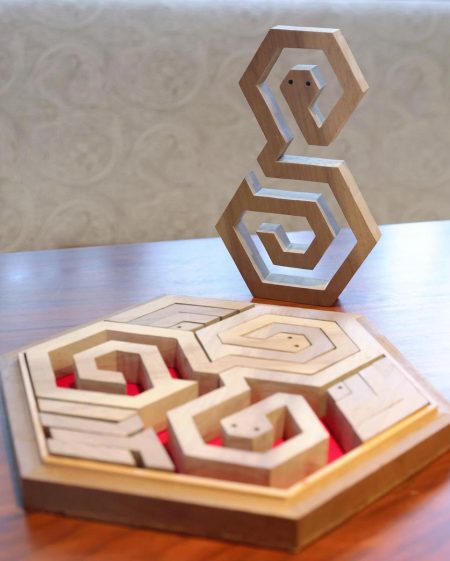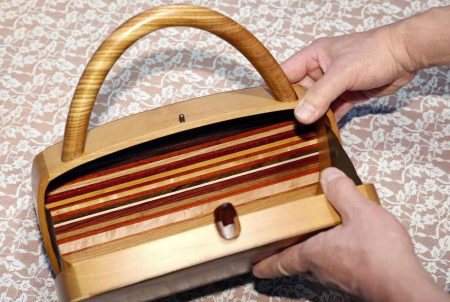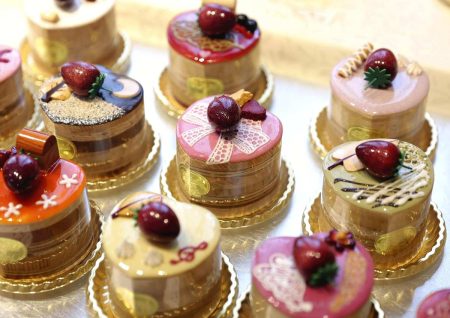November 24, 2025
TOKYO – Wooden bags made by Satoshi Kumano come in various types, including swagger bags and clutches.

Satoshi Kumano. PHOTO: THE YOMIURI SHIMBUN
Though they are stunning craftworks, they are also durable enough for daily use. Their warm appearance makes them great accent pieces.
The designs are simple yet have depth, as the beauty of the wood grain is fully utilized.
The bags made by the 70-year-old wood craftsman have an elegant yet playful spirit. Users will enjoy opening, closing and holding them.
Kumano also pays careful attention to the durability of his products. He developed his technique by conducting “repeated studies, such as checking how bags were broken or damaged when dropped from waist height.”

This object featuring snake shapes was made by Kumano during his university years. PHOTO: THE YOMIURI SHIMBUN
He began producing wooden bags around the year 2000. Until then, he had mainly produced music boxes. When producing bags, not only good designs but also user-friendliness are important requirements.
“Because higher-level skills are necessary [to make bags like these], I wanted to take on the challenge,” he said.
Kumano uses techniques used for making Sendai Tansu chests of drawers to produce wooden bags.
For example, when preparing wood material, he dries the wood, which initially contains more than 10% moisture, until it is completely dry. Then, he leaves the wood unattended for a while.
He said that by going through this process, he ensures the wood does not become deformed or cracked.

The parquet bag has a beautiful appearance inside and out. PHOTO: THE YOMIURI SHIMBUN
Lightness is also an important factor because the bags are carried by hand. To ensure the bags’ strength, he utilizes methods such as thickening the joint parts. He also thoroughly rasps the handles to make them sufficiently round.
Kumano was born into a family of Sendai Tansu craftsmen in 1955. During his childhood, he acquired craftsmanship skills while working as an assistant in the production studio.

Many kinds of wood are used to make the bags. PHOTO: THE YOMIURI SHIMBUN
At university where he studied industrial design, he made wooden play equipment for his graduation project. He has always searched for a wider range of possibilities with wood materials.
“I want people to use [the bags] for as long as possible,” he said. The philosophy which he has fostered through producing traditional craftworks has never changed.
In 2000, he won the grand prix award for his wooden bags in the Miyagi Monozukuri Taisho contest and won an award for excellence with his cake-shaped music boxes in the 10th contest for new souvenir design in the Tohoku region.
He has sometimes held solo exhibitions in Tokyo, and recently, his works have become popular with foreign tourists.
“I feel my skills as a craftsman are improving with each passing year. My ideas never run out and I have many more to come,” Kumano said.
Cake-shaped music boxes
Music boxes that look like shortcakes. PHOTO: THE YOMIURI SHIMBUN
In a gallery attached to Kumanodo, a production studio which Kumano runs, music boxes that look like real shortcakes are on display.
After the 2011 Great East Japan Earthquake, Kumano thought, “I want to brighten people’s hearts.” Then he began full-fledged production of shortcake-shaped music boxes, in addition to ordinary ones.
To produce the cake-shaped boxes, he used techniques such as extracting pigments from trees and mixing wood powders with adhesive to create the appearance of fresh cream. He also decorated the surfaces with crushed eggshells and sawdust.
“Though what I pursue is different from others in making wooden bags, I want people to enjoy beautiful sounds along with the attractiveness of wood,” Kumano said.


AloJapan.com